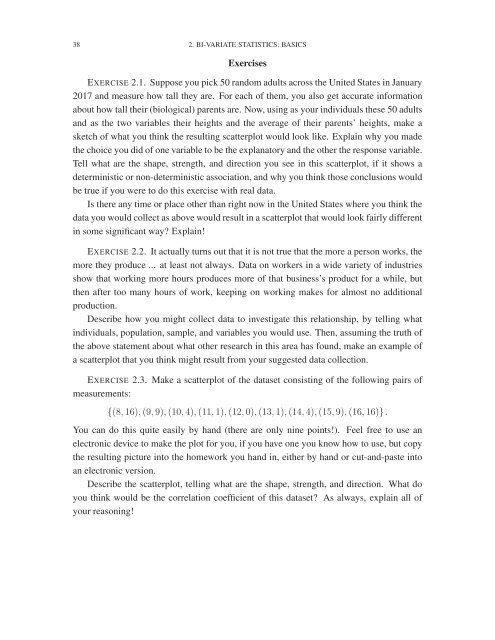Lies, Damned Lies, or Statistics- How to Tell the Truth with Statistics, 2017a
Lies, Damned Lies, or Statistics- How to Tell the Truth with Statistics, 2017a
Lies, Damned Lies, or Statistics- How to Tell the Truth with Statistics, 2017a
Create successful ePaper yourself
Turn your PDF publications into a flip-book with our unique Google optimized e-Paper software.
38 2. BI-VARIATE STATISTICS: BASICS<br />
Exercises<br />
EXERCISE 2.1. Suppose you pick 50 random adults across <strong>the</strong> United States in January<br />
2017 and measure how tall <strong>the</strong>y are. F<strong>or</strong> each of <strong>the</strong>m, you also get accurate inf<strong>or</strong>mation<br />
about how tall <strong>the</strong>ir (biological) parents are. Now, using as your individuals <strong>the</strong>se 50 adults<br />
and as <strong>the</strong> two variables <strong>the</strong>ir heights and <strong>the</strong> average of <strong>the</strong>ir parents’ heights, make a<br />
sketch of what you think <strong>the</strong> resulting scatterplot would look like. Explain why you made<br />
<strong>the</strong> choice you did of one variable <strong>to</strong> be <strong>the</strong> explanat<strong>or</strong>y and <strong>the</strong> o<strong>the</strong>r <strong>the</strong> response variable.<br />
<strong>Tell</strong> what are <strong>the</strong> shape, strength, and direction you see in this scatterplot, if it shows a<br />
deterministic <strong>or</strong> non-deterministic association, and why you think those conclusions would<br />
be true if you were <strong>to</strong> do this exercise <strong>with</strong> real data.<br />
Is <strong>the</strong>re any time <strong>or</strong> place o<strong>the</strong>r than right now in <strong>the</strong> United States where you think <strong>the</strong><br />
data you would collect as above would result in a scatterplot that would look fairly different<br />
in some significant way? Explain!<br />
EXERCISE 2.2. It actually turns out that it is not true that <strong>the</strong> m<strong>or</strong>e a person w<strong>or</strong>ks, <strong>the</strong><br />
m<strong>or</strong>e <strong>the</strong>y produce ... at least not always. Data on w<strong>or</strong>kers in a wide variety of industries<br />
show that w<strong>or</strong>king m<strong>or</strong>e hours produces m<strong>or</strong>e of that business’s product f<strong>or</strong> a while, but<br />
<strong>the</strong>n after <strong>to</strong>o many hours of w<strong>or</strong>k, keeping on w<strong>or</strong>king makes f<strong>or</strong> almost no additional<br />
production.<br />
Describe how you might collect data <strong>to</strong> investigate this relationship, by telling what<br />
individuals, population, sample, and variables you would use. Then, assuming <strong>the</strong> truth of<br />
<strong>the</strong> above statement about what o<strong>the</strong>r research in this area has found, make an example of<br />
a scatterplot that you think might result from your suggested data collection.<br />
EXERCISE 2.3. Make a scatterplot of <strong>the</strong> dataset consisting of <strong>the</strong> following pairs of<br />
measurements:<br />
{(8, 16), (9, 9), (10, 4), (11, 1), (12, 0), (13, 1), (14, 4), (15, 9), (16, 16)}.<br />
You can do this quite easily by hand (<strong>the</strong>re are only nine points!). Feel free <strong>to</strong> use an<br />
electronic device <strong>to</strong> make <strong>the</strong> plot f<strong>or</strong> you, if you have one you know how <strong>to</strong> use, but copy<br />
<strong>the</strong> resulting picture in<strong>to</strong> <strong>the</strong> homew<strong>or</strong>k you hand in, ei<strong>the</strong>r by hand <strong>or</strong> cut-and-paste in<strong>to</strong><br />
an electronic version.<br />
Describe <strong>the</strong> scatterplot, telling what are <strong>the</strong> shape, strength, and direction. What do<br />
you think would be <strong>the</strong> c<strong>or</strong>relation coefficient of this dataset? As always, explain all of<br />
your reasoning!

















